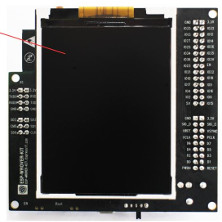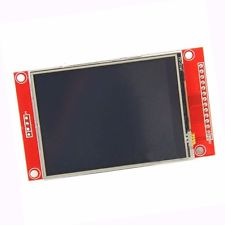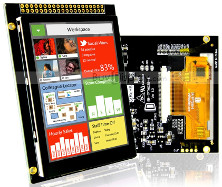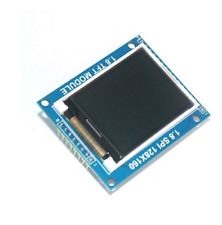https://github.com/loboris/esp32_tft_library
Full featured TFT library for ESP32 with demo application
https://github.com/loboris/esp32_tft_library
demo display esp-wrover-kit esp32 ili9341 ili9488 library tft
Last synced: 8 months ago
JSON representation
Full featured TFT library for ESP32 with demo application
- Host: GitHub
- URL: https://github.com/loboris/esp32_tft_library
- Owner: loboris
- Created: 2017-05-21T18:49:05.000Z (over 8 years ago)
- Default Branch: master
- Last Pushed: 2024-06-19T01:46:09.000Z (over 1 year ago)
- Last Synced: 2025-04-04T04:12:26.951Z (9 months ago)
- Topics: demo, display, esp-wrover-kit, esp32, ili9341, ili9488, library, tft
- Language: C
- Homepage:
- Size: 24.6 MB
- Stars: 599
- Watchers: 29
- Forks: 222
- Open Issues: 66
-
Metadata Files:
- Readme: README.md
Awesome Lists containing this project
README
### TFT library for ESP32
---
**This library must be built with the latest esp-idf master branch and xtensa toolchain**
If you are using the esp-idf v2.1, checkout the commit *0518df81a6566820352dad7bf6c539995d41ad18*
---
#### Features
* Full support for **ILI9341**, **ILI9488**, **ST7789V** and **ST7735** based TFT modules in 4-wire SPI mode. Support for other controllers will be added later
* **18-bit (RGB)** color mode used
* **SPI displays oriented SPI driver library** based on *spi-master* driver
* Combined **DMA SPI** transfer mode and **direct SPI** for maximal speed
* **Grayscale mode** can be selected during runtime which converts all colors to gray scale
* SPI speeds up to **40 MHz** are tested and works without problems
* **Demo application** included which demonstrates most of the library features
* **Graphics drawing functions**:
* **TFT_drawPixel** Draw pixel at given x,y coordinates
* **TFT_drawLine** Draw line between two points
* **TFT_drawFastVLine**, **TFT_drawFastHLine** Draw vertical or horizontal line of given lenght
* **TFT_drawLineByAngle** Draw line on screen from (x,y) point at given angle
* **TFT_drawRect**, **TFT_fillRect** Draw rectangle on screen or fill given rectangular screen region with color
* **TFT_drawRoundRect**, **TFT_fillRoundRect** Draw rectangle on screen or fill given rectangular screen region with color with rounded corners
* **TFT_drawCircle**, **TFT_fillCircle** Draw or fill circle on screen
* **TFT_drawEllipse**, **TFT_fillEllipse** Draw or fill ellipse on screen
* **TFT_drawTriangel**, **TFT_fillTriangle** Draw or fill triangle on screen
* **TFT_drawArc** Draw circle arc on screen, from ~ to given angles, with given thickness. Can be outlined with different color
* **TFT_drawPolygon** Draw poligon on screen with given number of sides (3~60). Can be outlined with different color and rotated by given angle.
* **Fonts**:
* **fixed** width and proportional fonts are supported; 8 fonts embeded
* unlimited number of **fonts from file**
* **7-segment vector font** with variable width/height is included (only numbers and few characters)
* Proportional fonts can be used in fixed width mode.
* Related functions:
* **TFT_setFont** Set current font from one of embeded fonts or font file
* **TFT_getfontsize** Returns current font height & width in pixels.
* **TFT_getfontheight** Returns current font height in pixels.
* **set_7seg_font_atrib** Set atributes for 7 segment vector font
* **getFontCharacters** Get all font's characters to buffer
* **String write function**:
* **TFT_print** Write text to display.
* Strings can be printed at **any angle**. Rotation of the displayed text depends on *font_ratate* variable (0~360)
* if *font_transparent* variable is set to 1, no background pixels will be printed
* If the text does not fit the screen/window width it will be clipped ( if *text_wrap=0* ), or continued on next line ( if *text_wrap=1* )
* Two special characters are allowed in strings: *\r* CR (0x0D), clears the display to EOL, *\n* LF (ox0A), continues to the new line, x=0
* Special values can be entered for X position:
* *CENTER* centers the text
* *RIGHT* right justifies the text horizontaly
* *LASTX* continues from last X position; offset can be used: *LASTX+n*
* Special values can be entered for Y:
* *CENTER* centers the text verticaly
* *BOTTOM* bottom justifies the text
* *LASTY* continues from last Y position; offset can be used: *LASTY+n*
* **TFT_getStringWidth** Returns the string width in pixels based on current font characteristics. Useful for positioning strings on the screen.
* **TFT_clearStringRect** Fills the rectangle occupied by string with current background color
* **Images**:
* **TFT_jpg_image** Decodes and displays JPG images
* Limits:
* Baseline only. Progressive and Lossless JPEG format are not supported.
* Image size: Up to 65520 x 65520 pixels
* Color space: YCbCr three components only. Gray scale image is not supported.
* Sampling factor: 4:4:4, 4:2:2 or 4:2:0.
* Can display the image **from file** or **memory buffer**
* Image can be **scaled** by factor 0 ~ 3 (1/1, 1/2, 1/4 or 1/8)
* Image is displayed from X,Y position on screen/window:
* X: image left position; constants CENTER & RIGHT can be used; *negative* value is accepted
* Y: image top position; constants CENTER & BOTTOM can be used; *negative* value is accepted
* **TFT_bmp_image** Decodes and displays BMP images
* Only uncompressed RGB 24-bit with no color space information BMP images can be displayed
* Can display the image **from file** or **memory buffer**
* Image can be **scaled** by factor 0 ~ 7; if scale>0, image is scaled by factor 1/(scale+1)
* Image is displayed from X,Y position on screen/window:
* X: image left position; constants CENTER & RIGHT can be used; *negative* value is accepted
* Y: image top position; constants CENTER & BOTTOM can be used; *negative* value is accepted
* **Window functions**:
* Drawing on screen can be limited to rectangular *window*, smaller than the full display dimensions
* When defined, all graphics, text and image coordinates are translated to *window* coordinates
* Related functions
* **TFT_setclipwin** Sets the *window* area coordinates
* **TFT_resetclipwin** Reset the *window* to full screen dimensions
* **TFT_saveClipWin** Save current *window* to temporary variable
* **TFT_restoreClipWin** Restore current *window* from temporary variable
* **TFT_fillWindow** Fill *window* area with color
* **Touch screen** supported (for now only **XPT2046** controllers)
* **TFT_read_touch** Detect if touched and return X,Y coordinates. **Raw** touch screen or **calibrated** values can be returned.
* calibrated coordinates are adjusted for screen orientation.
* **Read from display memory** supported
* **TFT_readPixel** Read pixel color value from display GRAM at given x,y coordinates.
* **TFT_readData** Read color data from rectangular screen area
* **Other display functions**:
* **TFT_fillScreen** Fill the whole screen with color
* **TFT_setRotation** Set screen rotation; PORTRAIT, PORTRAIT_FLIP, LANDSCAPE and LANDSCAPE_FLIP are supported
* **TFT_invertDisplay** Set inverted/normal colors
* **TFT_compare_colors** Compare two color structures
* **disp_select()** Activate display's CS line
* **disp_deselect()** Deactivate display's CS line
* **find_rd_speed()** Find maximum spi clock for successful read from display RAM
* **TFT_display_init()** Perform display initialization sequence. Sets orientation to landscape; clears the screen. SPI interface must already be setup, *tft_disp_type*, *_width*, *_height* variables must be set.
* **HSBtoRGB** Converts the components of a color, as specified by the HSB model to an equivalent set of values for the default RGB model.
* **TFT_setGammaCurve()** Select one of 4 Gamma curves
* **compile_font_file** Function which compiles font c source file to font file which can be used in *TFT_setFont()* function to select external font. Created file have the same name as source file and extension *.fnt*
* **Global wariables**
* **orientation** current screen orientation
* **font_ratate** current font rotate angle (0~395)
* **font_transparent** if not 0 draw fonts transparent
* **font_forceFixed** if not zero force drawing proportional fonts with fixed width
* **text_wrap** if not 0 wrap long text to the new line, else clip
* **_fg** current foreground color for fonts
* **_bg** current background for non transparent fonts
* **dispWin** current display clip window
* **_angleOffset** angle offset for arc, polygon and line by angle functions
* **image_debug** print debug messages during image decode if set to 1
* **cfont** Currently used font structure
* **TFT_X** X position of the next character after TFT_print() function
* **TFT_Y** Y position of the next character after TFT_print() function
* **tp_calx** touch screen X calibration constant
* **tp_caly** touch screen Y calibration constant
* **gray_scale** convert all colors to gray scale if set to 1
* **max_rdclock** current spi clock for reading from display RAM
* **_width** screen width (smaller dimension) in pixels
* **_height** screen height (larger dimension) in pixels
* **tft_disp_type** current display type (DISP_TYPE_ILI9488 or DISP_TYPE_ILI9341)
---
Full functions **syntax and descriptions** can be found in *tft.h* and *tftspi.h* files.
Full **demo application**, well documented, is included, please **analyze it** to learn how to use the library functions.
---
#### Connecting the display
| ESP32 pin | Display module | Notes |
| - | - | - |
| Any output pin | MOSI | SPI input on Display module |
| Any pin | MISO | SPI output from Display module, optional |
| Any output pin | SCK | SPI clock input on Display module |
| Any output pin | CS | SPI CS input on Display module |
| Any output pin | DC | DC (data/command) input on Display module |
| Any output pin | TCS | Touch pannel CS input (if touch panel is used |
| Any output pin | RST | **optional**, reset input of the display module, if not used **pullup the reset input** to Vcc |
| Any output pin | BL | **optional**, backlight input of the display module, if not used connect to +3.3V (or +5V) |
| GND | GND | Power supply ground |
| 3.3V or +5V | Vcc | Power supply positive |
**Make shure the display module has 3.3V compatible interface, if not you must use level shifter!**
---
To run the demo, attach ILI9341, ILI9488 or ST7735 based display module to ESP32. Default pins used are:
* mosi: 23
* miso: 19
* sck: 18
* CS: 5 (display CS)
* DC: 26 (display DC)
* TCS: 25 (touch screen CS)
---
*To run the demo on* **ESP-WROWER-KIT v3** *select the following pin configuration:*
* mosi: 23
* miso: 25
* sck: 19
* CS: 22 (display CS)
* DC: 21 (display DC)
* TCS: 0 (touch screen CS), not used
* RST: 18 (display RESET)
* BKLIT: 5 (Display Back light)
Also set **TFT_RGB_BGR** to 0x00 and **TFT_INVERT_ROTATION1** to 1 in *tftspi.h*
**You can also select EXAMPLE_ESP_WROVER_KIT in menuconfig to automaticaly define correct configuration**
---
**If you want to use different pins, change them in** *tftspi.h*
**if you want to use the touch screen functions, set** `#define USE_TOUCH 1` in *tftspi.h*
Using *make menuconfig* **select tick rate 1000** ( → Component config → FreeRTOS → Tick rate (Hz) ) to get more accurate timings
---
#### How to build
Configure your esp32 build environment as for **esp-idf examples**
Clone the repository
`git clone https://github.com/loboris/ESP32_TFT_library.git`
Execute menuconfig and configure your Serial flash config and other settings. Included *sdkconfig.defaults* sets some defaults to be used.
Navigate to **TFT Display DEMO Configuration** and set **SPIFFS** options.
Select if you want to use **wifi** (recommended) to get the time from **NTP** server and set your WiFi SSID and password.
`make menuconfig`
Make and flash the example.
`make all && make flash`
---
#### Prepare **SPIFFS** image
*The demo uses some image and font files and it is necessary to flash the spiffs image*
**To flash already prepared image to flash** execute:
`make copyfs`
---
You can also prepare different SFPIFFS **image** and flash it to ESP32. *This feature is only tested on Linux.*
Files to be included on spiffs are already in **components/spiffs_image/image/** directory. You can add or remove the files you want to include.
Then execute:
`make makefs`
to create **spiffs image** in *build* directory **without flashing** to ESP32
Or execute:
`make flashfs`
to create **spiffs image** in *build* directory and **flash** it to ESP32
---
---
**Example output:**
```
I (0) cpu_start: App cpu up.
I (312) heap_init: Initializing. RAM available for dynamic allocation:
I (319) heap_init: At 3FFAE6E0 len 00001920 (6 KiB): DRAM
I (325) heap_init: At 3FFBB0B8 len 00024F48 (147 KiB): DRAM
I (331) heap_init: At 3FFE0440 len 00003BC0 (14 KiB): D/IRAM
I (338) heap_init: At 3FFE4350 len 0001BCB0 (111 KiB): D/IRAM
I (344) heap_init: At 40091F94 len 0000E06C (56 KiB): IRAM
I (350) cpu_start: Pro cpu start user code
I (144) cpu_start: Starting scheduler on PRO CPU.
I (0) cpu_start: Starting scheduler on APP CPU.
==============================
TFT display DEMO, LoBo 09/2017
==============================
SPI: display device added to spi bus (2)
SPI: attached display device, speed=8000000
SPI: bus uses native pins: false
SPI: display init...
OK
SPI: Changed speed to 26666666
---------------------
Graphics demo started
---------------------
I (2815) [TFT Demo]: Time is not set yet. Connecting to WiFi and getting time over NTP.
I (2845) wifi: wifi firmware version: ee52423
I (2846) wifi: config NVS flash: enabled
I (2846) wifi: config nano formating: disabled
I (2846) system_api: Base MAC address is not set, read default base MAC address from BLK0 of EFUSE
I (2856) system_api: Base MAC address is not set, read default base MAC address from BLK0 of EFUSE
I (2890) wifi: Init dynamic tx buffer num: 32
I (2890) wifi: Init data frame dynamic rx buffer num: 32
I (2890) wifi: Init management frame dynamic rx buffer num: 32
I (2894) wifi: wifi driver task: 3ffc83d8, prio:23, stack:4096
I (2899) wifi: Init static rx buffer num: 10
I (2903) wifi: Init dynamic rx buffer num: 32
I (2907) wifi: Init rx ampdu len mblock:7
I (2911) wifi: Init lldesc rx ampdu entry mblock:4
I (2916) wifi: wifi power manager task: 0x3ffcd844 prio: 21 stack: 2560
I (2922) [TFT Demo]: Setting WiFi configuration SSID LoBoInternet...
I (2951) phy: phy_version: 359.0, e79c19d, Aug 31 2017, 17:06:07, 0, 0
I (2951) wifi: mode : sta (24:0a:c4:11:a4:0c)
I (3073) wifi: n:11 0, o:1 0, ap:255 255, sta:11 0, prof:1
I (3731) wifi: state: init -> auth (b0)
I (3734) wifi: state: auth -> assoc (0)
I (3738) wifi: state: assoc -> run (10)
I (3776) wifi: connected with LoBoInternet, channel 11
I (5827) event: ip: 192.168.0.21, mask: 255.255.255.0, gw: 192.168.0.1
I (5828) [TFT Demo]: Initializing SNTP
I (6331) [TFT Demo]: System time is set.
I (6331) wifi: state: run -> init (0)
I (6332) wifi: n:11 0, o:11 0, ap:255 255, sta:11 0, prof:1
I (6344) wifi: flush txq
I (6344) wifi: stop sw txq
I (6344) wifi: lmac stop hw txq
E (6344) wifi: esp_wifi_connect 836 wifi not start
I (8441) [SPIFFS]: Registering SPIFFS file system
I (8441) [SPIFFS]: Mounting SPIFFS files system
I (8441) [SPIFFS]: Start address: 0x280000; Size 1024 KB
I (8447) [SPIFFS]: Work buffer: 2048 B
I (8451) [SPIFFS]: FDS buffer: 384 B
I (8456) [SPIFFS]: Cache size: 2048 B
I (8500) [SPIFFS]: Mounted
==========================================
Display: ILI9488: PORTRAIT 240,320 Color
Clear screen time: 60 ms
Send color buffer time: 228 us (240 pixels)
JPG Decode time: 287 ms
BMP time, scale: 5: 422 ms
BMP time, scale: 4: 431 ms
BMP time, scale: 3: 430 ms
BMP time, scale: 2: 434 ms
BMP time, scale: 1: 442 ms
BMP time, scale: 0: 335 ms
==========================================
Display: ILI9488: LANDSCAPE 320,240 Color
Clear screen time: 57 ms
Send color buffer time: 301 us (320 pixels)
I (126333) event: station ip lost
JPG Decode time: 286 ms
BMP time, scale: 5: 422 ms
BMP time, scale: 4: 431 ms
BMP time, scale: 3: 433 ms
BMP time, scale: 2: 435 ms
BMP time, scale: 1: 444 ms
BMP time, scale: 0: 260 ms
==========================================
Display: ILI9488: PORTRAIT FLIP 240,320 Color
Clear screen time: 60 ms
Send color buffer time: 228 us (240 pixels)
JPG Decode time: 287 ms
BMP time, scale: 5: 420 ms
BMP time, scale: 4: 430 ms
BMP time, scale: 3: 429 ms
BMP time, scale: 2: 436 ms
BMP time, scale: 1: 446 ms
BMP time, scale: 0: 338 ms
==========================================
Display: ILI9488: PORTRAIT FLIP 240,320 Color
Clear screen time: 60 ms
Send color buffer time: 228 us (240 pixels)
JPG Decode time: 287 ms
BMP time, scale: 5: 420 ms
BMP time, scale: 4: 430 ms
BMP time, scale: 3: 429 ms
BMP time, scale: 2: 436 ms
BMP time, scale: 1: 446 ms
BMP time, scale: 0: 338 ms
```
---
### Tested on
ESP32-WROVER-KIT v3, ST7789V controller, 240x320

2.4" 240x320 ILI9341 conroller with Touch panel from eBay

3.5" 320x480 ILI9844 controller with Touch panel from BuyDisplay

1.8" 128x160 ST7735 conroller from eBay
